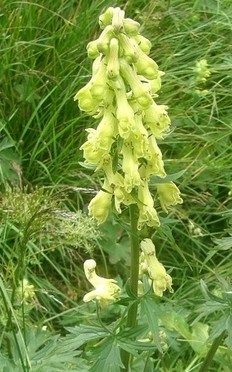 A native of southern Europe, this herbaceous perennial grows in mountain woods and meadows, often near streams, in moist peaty soils. Although there is a purple flowered variety, the primrose yellow variety adds another color to the palette of tall plants available o gardeners and flower arrangers. The yellow to lime green flowers are carried on spikes over deeply lobed, dark green foliage. Like other aconites, the flowers parts are tucked under an enlarged sepal which resembles a hood and gives the whole genus the common name of monkshood. The roots were commonly used as a poison for wolves, giving rise to another common name, wolfsbane and to the specific epithet, lycoctonum from the Greek lykos meaning wolf, and ktonos meaning murder. Unfortunately the flowering period in late summer is short and the plant needs staking. Both flowers and seed heads are attractive in flower arrangements and a few stems in a summer bouquet of white and yellow flowers is enticing. Like other species in this genus, all parts of the plant are poisonous.
A native of southern Europe, this herbaceous perennial grows in mountain woods and meadows, often near streams, in moist peaty soils. Although there is a purple flowered variety, the primrose yellow variety adds another color to the palette of tall plants available o gardeners and flower arrangers. The yellow to lime green flowers are carried on spikes over deeply lobed, dark green foliage. Like other aconites, the flowers parts are tucked under an enlarged sepal which resembles a hood and gives the whole genus the common name of monkshood. The roots were commonly used as a poison for wolves, giving rise to another common name, wolfsbane and to the specific epithet, lycoctonum from the Greek lykos meaning wolf, and ktonos meaning murder. Unfortunately the flowering period in late summer is short and the plant needs staking. Both flowers and seed heads are attractive in flower arrangements and a few stems in a summer bouquet of white and yellow flowers is enticing. Like other species in this genus, all parts of the plant are poisonous.
Cutting: No special requirements
Conditioning: Give a long drink in deep warm water.
Preserving: Hang seed heads up side-sown in dry, warm room
Cultivation:
Size: 3-4.5’ h x 2’ W
Light: Full sun to partial shade
Soil: Fertile, medium moist, well-drained
Hardiness: Zones 5-8
Propagation: Seed
Care: Stake plants as needed; cut the old stems down to ground level in fall.